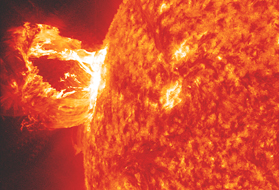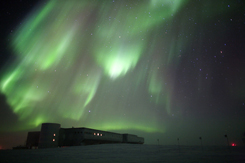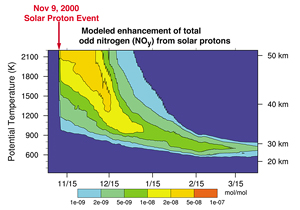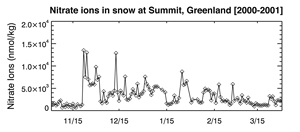Spring 2014
Space and Earth Systems Science
TWO YEARS AGO, the National Science Foundation-funded "Sun-to-Ice" project headed up by EOS scientists set out to establish a firm connection between explosive events on the sun and an associated chemical signature locked away in polar ice cores.
 |
|
|
A solar prominence eruption associated with a solar flare captured by NASA's Solar Dynamics Observatory. Image courtesy of NASA Goddard Space Flight Center. |
That a signature of the chemical nitrate occurs as a result of this process has been the subject of debate and controversy for decades. If proven, it would provide a powerful new tool for understanding the elusive past history of our unpredictably violent star, and potentially protect us from a devastating "Black Swan" event—a rare, unexpected occurrence of large magnitude and consequence—that would cripple global power grids, render satellites useless, and bring modern-day society to its knees.
Such an event occurred in 1859 when the one-two punch of a solar flare and coronal mass ejection propelled a massive stream of high-energy particles directly toward Earth in a matter of hours rather than days. The subsequent geomagnetic storm, known as the Carrington Event, created aurora so bright that newspapers could be read under night skies and telegraph systems across Europe and North America were brought down. In some cases, telegraph operators received powerful shocks and telegraph lines burst into flame or continued to send and receive messages independent of their power supplies.
"Today, we are a highly technological society dependent on space in fundamental and deep ways that are largely invisible to most people," notes Harlan Spence, Sun-to-Ice principal investigator and director of EOS. "In fact, we are so vulnerable to the effects of what is now called 'space weather' that the Department of Homeland Security includes it as one of its top natural disasters."
He adds, "It is very unlikely to occur, but if the sun unleashed something huge it could be utterly devastating, particularly if the Carrington Event was relatively small compared to what the sun is capable of—something we're completely in the dark on because we have no record of the sun's explosive behavior on longer timescales."
Which brings us back to Sun-to-Ice. The five-year project, one of the first funded under NSF's recent Frontiers in Earth-System Dynamics program, crosses the boundaries between space physics, atmospheric, and ice core science and is investigating, modeling, and testing the complex, interlinked physical processes at the frontier of the dynamic sun-Earth system.
This chain of processes begins with the initiation and evolution of the powerful coronal mass ejections—which propel more than a billion tons of the sun's outer atmosphere hurtling into space at speeds of more than a million miles per hour —moves to solar energetic particle acceleration and transport through space, and, finally, leads to particle effects in the atmosphere, access to the polar caps, and chemical signatures in ice cores.
"The project ultimately seeks to understand this whole chain, looking for signals frozen in polar ice as a history of extreme solar events that have affected our planet," says Spence.
The way science works
Two years in, the project achieved a major milestone by using a state-of-the-art global climate model and a unique dataset of snow samples collected by EOS scientists to show that nitrate signatures in ice are largely due to sources other than solar energetic particles and cannot be reliably used as a means of reconstructing the sun's history. Thus, the effort to use nitrate signals to peer backward through ice cores in search of Black Swan solar events appears to have been laid to rest.
Sun-to-Ice team member Katharine Duderstadt, an Earth Systems Research Center research scientist, used the National Center for Atmospheric Research's Whole Atmosphere Climate Coupled Model—WACCM for short and pronounced "whack'em"—to look at two specific modern-day solar proton events for potential signatures in Arctic ice. Snow pit data gathered in Summit, Greenland by ESRC's Jack Dibb, also a project team member, during these same two events was also used as part of the modeling effort.
The unique value of the snow pit data was that it included other potential sources or "tracers" for creating a nitrate spike—different tracers of pollution, biomass burning, or storms coming off the ocean. The team also had accurate records of the atmospheric conditions above Greenland at the time of the solar events to help drive the model.
Duderstadt's model runs allowed her to back out whether or not these different sources were the likely candidates for any nitrate spikes. In the final analysis they were, and solar protons were not. (See related story, "Renaissance Woman," for more details on Duderstadt's modeling effort and what's next for the Sun-to-Ice project.)
Notes Spence, "On the one hand this is disappointing and discouraging since our hope was to be able to finally make a causal correlation between solar events and nitrate spikes. But this is exactly how science sometimes works and we can now shift direction to other avenues of inquiry."
Moreover, the project still retains the main science question that drives it: to try and understand what the sun has done in the past. And, Spence notes further, the nitrate-solar proton connection was not necessarily the most logical or strongest avenue to follow.
Looking under a different lamppost
"In a way, nitrate spikes were lampposts and people have been looking under that same lamppost because we had records of nitrates," Spence says. "If you turn the problem around and say, 'What signal should we see in the ice, what chemical tracers would give a robust signature?' you wouldn't necessarily start with nitrate. It just happened that's what people were looking at for other reasons and found these spikes."
 |
|
| Aurora in the night sky at the Kjell Henriksen Observatory in Svalbard, Norway in November 2010. Image courtesy of Njaal Gulbarndsen. |
Moreover, project team member and atmospheric chemist Dibb notes that, from the perspective of glaciochemical and atmospheric chemistry scientists, the ice-core/nitrate-spike connection has not been a viable one for decades.
Says Dibb, "The space weather community has pursued this for awhile because it would have provided a new tool for looking at the sun's past history, but let us hope that the WACCM modeling we did as part of this project will help to finally lay that notion to rest."
Since there is a whole chain of events involved in the Sun-to-Ice journey, and unknowns and controversies at each link in the chain, Spence asserts that the modeling has made tremendous progress in better understanding what's happening at the sun to generate the eruptions, what's happening in the interplanetary medium to accelerate particles, what's happening in the entry into the magnetosphere and the upper atmosphere, and even the sun's influence on our protective ozone layer.
"One of the goals of the project was to really understand how these links work. And I think at this point we can confidently say we're one link short—that final 'to-ice' piece—and are looking to see if we can get that Rosetta Stone to the sun's past history."
Additional UNH scientists on the Sun-to-Ice project include Nathan Schwadron and Terry Forbes of the Space Science Center and Ruth Varner of the Earth Systems Research Center.


